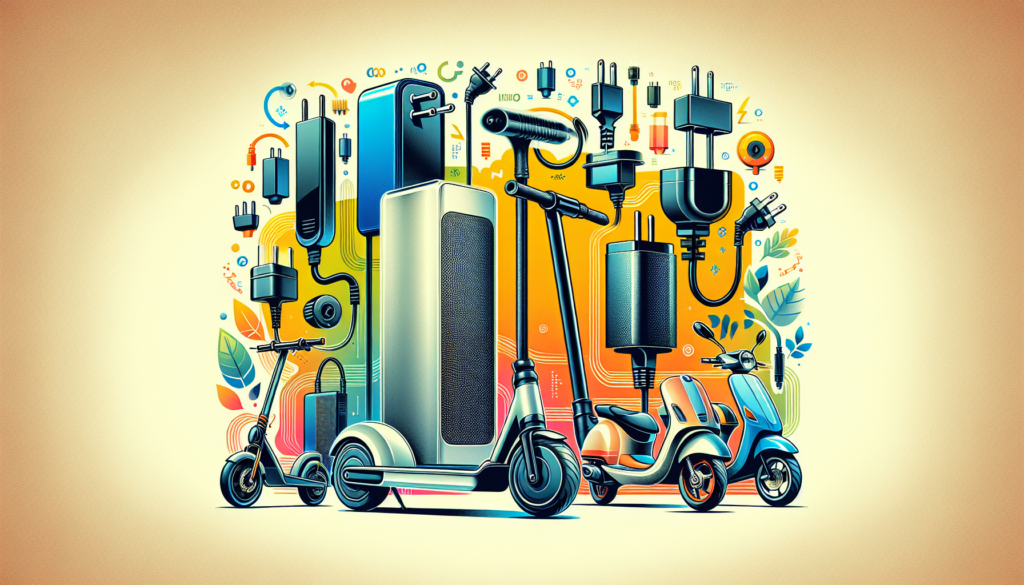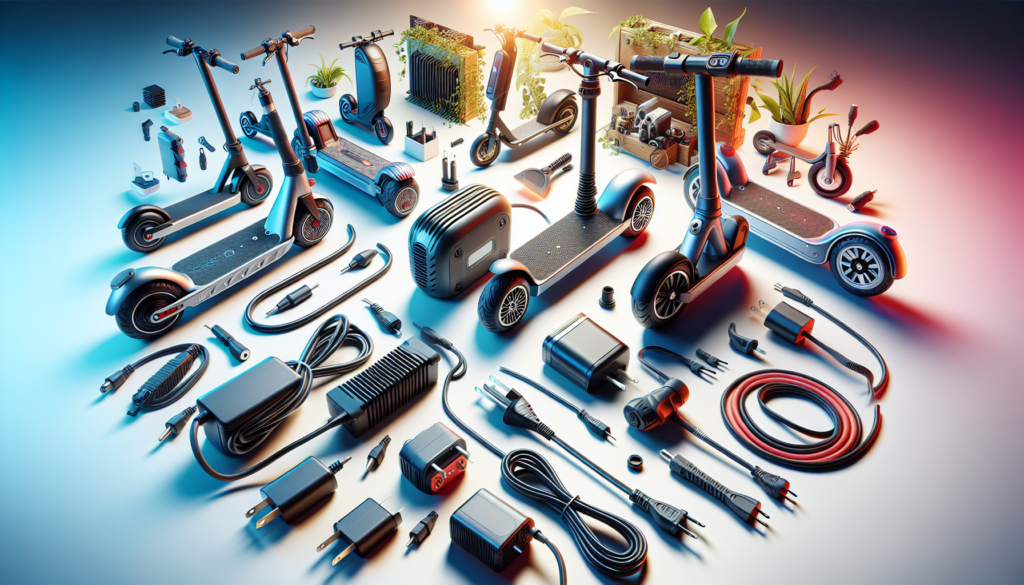If you’ve ever found yourself in need of a convenient and efficient way to charge your electric scooter, then electric scooter chargers are the answer you’ve been searching for. These chargers are specifically designed to provide a reliable and fast charging experience for your electric scooter, ensuring that you’re always ready to hit the road with minimal downtime. With their sleek and compact design, electric scooter chargers are incredibly portable, making them perfect for on-the-go charging. Whether you’re a daily commuter or simply enjoy cruising around town, electric scooter chargers are the must-have accessory to keep your electric scooter powered up and ready for your next adventure.

Types of Electric Scooter Chargers
Standard Chargers
Standard chargers are the most common type of electric scooter chargers available in the market. These chargers usually come with the scooter when you purchase it, and they are designed to provide a slow and steady charge to the scooter’s battery. Standard chargers are typically affordable and easy to use, making them a popular choice for many scooter owners. However, it’s important to note that charging time with standard chargers can be longer compared to other types of chargers.
Fast Chargers
If you’re looking for a quicker way to charge your electric scooter, a fast charger may be the right choice for you. Fast chargers are designed to provide a higher charging output, resulting in faster charging times for your scooter’s battery. This can be especially beneficial if you need to charge your scooter quickly before heading out for a ride. It’s important to note that while fast chargers can provide quick charging times, they may also require a higher voltage input, so it’s essential to ensure that your scooter’s battery and charging port are compatible with the specifications of the fast charger.
Portable Chargers
For those who are always on the go or need to charge their electric scooter outside of their home, a portable charger can be a great option. Portable chargers are compact in size and lightweight, making them easy to carry around in a bag or backpack. These chargers typically have a lower charging output than standard or fast chargers, but their portability makes them ideal for travelers or individuals who frequently use their scooter for commuting. Portable chargers are convenient for charging your scooter when you’re away from a power outlet or in a location where electricity is limited.
Wireless Chargers
Wireless chargers are the latest innovation in electric scooter charging technology. These chargers eliminate the need for cables and plugs, allowing you to simply place your scooter on a wireless charging pad. The charging pad uses magnetic induction to transfer power wirelessly to your scooter’s battery. Wireless chargers offer convenience and simplicity, as there are no cords to plug and unplug each time you want to charge your scooter. However, it’s important to note that wireless chargers may have slower charging times compared to other types of chargers.
Factors to Consider When Choosing a Charger
When selecting an electric scooter charger, it’s essential to consider several factors to ensure that it meets your specific needs. Here are some key factors to consider:
Charging Time
One of the most crucial factors to consider when choosing a charger is the charging time it provides. The charging time can vary depending on the charger’s output, the battery capacity of your electric scooter, and the charging technology used. If you need your scooter ready to ride quickly, a charger with faster charging times may be more suitable for your needs.
Portability
Consider how portable you need your charger to be. If you’re frequently on the go or need to charge your scooter at various locations, a portable charger that is lightweight and compact can be a valuable asset. However, if you mostly charge your scooter at home and portability is not a significant concern, then a larger and more powerful charger may be a better option.
Compatibility
Ensure that the charger you choose is compatible with your electric scooter’s specifications. Check the voltage requirements, connector type, and any specific compatibility guidelines provided by the scooter’s manufacturer. Using an incompatible charger can lead to damage to your scooter’s battery or charging port.
Safety Features
Safety should always be a top priority when it comes to charging your electric scooter. Look for chargers that offer safety features such as overcharge protection, overcurrent protection, short circuit protection, and temperature control. These features help prevent damage to your scooter’s battery and reduce the risk of accidents or malfunctions during the charging process.
Charging Time
Charger Output
The charging time of an electric scooter can be significantly influenced by the charger’s output. The higher the charger’s output, the faster it can charge the scooter’s battery. When comparing chargers, check the output specifications to determine how quickly the charger can charge your scooter.
Battery Capacity
The capacity of your electric scooter’s battery will also impact the charging time. A higher capacity battery may require a longer charging time compared to a scooter with a lower capacity battery. It’s essential to consider the battery capacity of your electric scooter when selecting a charger, as it will affect how quickly your scooter can be charged.
Charging Technology
Different chargers use various charging technologies, such as constant current charging or pulse charging. Each technology has its own advantages and disadvantages when it comes to charging time. It’s worth researching and understanding the charging technology used by different chargers to determine which one aligns with your needs and preferences.
Portability
Size and Weight
Portability is a crucial factor to consider, especially for individuals who frequently travel or need to charge their scooter in different locations. Smaller and lighter chargers are easier to carry around, making them more convenient for individuals on the go. However, it’s important to strike a balance between portability and charging power, as smaller chargers may have a lower charging output compared to larger ones.
Foldable Designs
Some chargers come with foldable designs that allow for easier storage and transportation. These chargers can be folded into a more compact size when not in use, making them space-efficient and easier to carry around. If storage and transportation are a concern, a foldable charger can be a practical choice.
Carrying Case
Certain chargers may come with a carrying case or bag, which can be useful for keeping the charger organized and protected during transportation. A carrying case can also provide additional convenience by offering designated compartments for cables and other accessories.

Compatibility
Voltage Requirement
When selecting a charger, it’s crucial to ensure that the charger is compatible with the voltage requirements of your electric scooter. Using a charger with an incorrect voltage input can result in damage to the scooter’s battery or charging port. Always refer to the manufacturer’s guidelines and specifications to determine the correct voltage requirement for your scooter.
Connector Type
Electric scooters can have different types of connectors for their charging ports. Before purchasing a charger, verify that the connector type matches the one on your scooter. Using a charger with the wrong connector type can prevent the charger from properly connecting to the scooter’s charging port.
Brand Specific Chargers
Some electric scooter manufacturers offer chargers that are specifically designed for their scooters. While brand-specific chargers can provide peace of mind in terms of compatibility, they may come at a higher price compared to generic chargers. Consider whether the added compatibility assurance justifies the potential higher cost when deciding on a charger.
Safety Features
Overcharge Protection
Overcharge protection is an essential safety feature that prevents the scooter’s battery from being overcharged. Overcharging can lead to decreased battery life, efficiency, and even pose a risk of battery failure. Chargers with overcharge protection systems automatically stop charging once the battery reaches its maximum capacity.
Overcurrent Protection
Overcurrent protection is designed to detect and prevent excessive current flow during the charging process. This feature ensures that the scooter’s battery is not exposed to currents that could cause damage or overheating. Chargers with overcurrent protection can help prolong the lifespan of your battery and prevent potential safety hazards.
Short Circuit Protection
Short circuit protection is a safety feature that safeguards your scooter’s battery from damage caused by a short circuit. If there is a sudden surge of electricity or a faulty connection, the short circuit protection feature will detect it and halt the charging process in order to prevent any potential harm.
Temperature Control
Chargers with temperature control features monitor the temperature of the battery during the charging process. If the temperature exceeds a safe threshold, the charger will adjust the charging rate or even pause the charging process to prevent overheating. Temperature control ensures the safety and longevity of your scooter’s battery.

Pros and Cons of Different Charger Types
Standard Chargers
Pros:
- Typically included with the purchase of an electric scooter
- Affordable and easily accessible
- Simplicity and ease of use
Cons:
- Slower charging times compared to fast chargers
- May not offer advanced safety features
Fast Chargers
Pros:
- Faster charging times compared to standard chargers
- Ideal for quick charging needs
- Can be beneficial for individuals with busy schedules
Cons:
- Some fast chargers may require a higher voltage input
- May be more expensive than standard chargers
Portable Chargers
Pros:
- Lightweight and compact design for easy portability
- Can be used in various locations and situations
- Ideal for travel and commuting purposes
Cons:
- Typically have a lower charging output compared to standard or fast chargers
- May have longer charging times
Wireless Chargers
Pros:
- Convenient and cable-free charging experience
- No need to deal with wires or plugs
- Offers simplicity and ease of use
Cons:
- Slower charging times compared to other charger types
- May require a specific wireless charging pad
Where to Buy Electric Scooter Chargers
Online Retailers
Online retailers such as Amazon, eBay, and specialized electric scooter websites are convenient and accessible sources for purchasing electric scooter chargers. These platforms offer a wide range of charger options, various price points, and customer reviews to help you make an informed decision.
Specialty Stores
Specialty stores that focus on electric scooters or electric mobility devices may carry a selection of chargers specifically designed for electric scooters. These stores often have knowledgeable staff who can guide you in choosing the right charger for your scooter’s needs.
Manufacturer’s Website
If you prefer to purchase directly from the manufacturer, many electric scooter companies have their own websites where you can find genuine and compatible chargers for your scooter. This option ensures the highest level of compatibility assurance but may have a higher price point.

Tips for Proper Charging
Follow Manufacturer’s Recommendations
Always refer to the manufacturer’s recommendations and guidelines for proper charging techniques specific to your electric scooter. Following these instructions ensures the optimum performance and lifespan of your scooter’s battery.
Avoid Overcharging
Overcharging can significantly decrease the lifespan and efficiency of your scooter’s battery. It’s important to avoid leaving your scooter connected to the charger for an extended period after the battery has reached its maximum capacity. Disconnecting the charger once the battery is fully charged helps maintain its longevity.
Use the Correct Voltage
Using a charger with an incorrect voltage input can cause damage to your scooter’s battery or charging port. Always double-check and ensure that the charger’s voltage matches the voltage requirements specified by the manufacturer.
Regularly Inspect the Charger
Regularly inspect the charger for any signs of damage or wear. If you notice any frayed cables, exposed wires, or other issues, it’s important to replace the charger to prevent any potential safety hazards. Discontinue using a charger that shows signs of damage.
Conclusion
When it comes to charging your electric scooter, selecting the right charger is crucial. Consider factors such as charging time, portability, compatibility, and safety features to ensure that the charger meets your specific needs. Whether you opt for a standard charger, a fast charger, a portable charger, or a wireless charger, each type has its own pros and cons. Take into account the charging needs of your electric scooter and choose a charger that aligns with those requirements. Proper charging techniques, such as following manufacturer recommendations, avoiding overcharging, and regularly inspecting the charger, can help extend the lifespan of your scooter’s battery and ensure a safe charging experience. Remember to purchase chargers from reputable sources such as online retailers, specialty stores, or the manufacturer’s website to guarantee compatibility and quality. With the right charger, you can enjoy long rides on your electric scooter with peace of mind knowing that your battery is always charged and ready to go.


